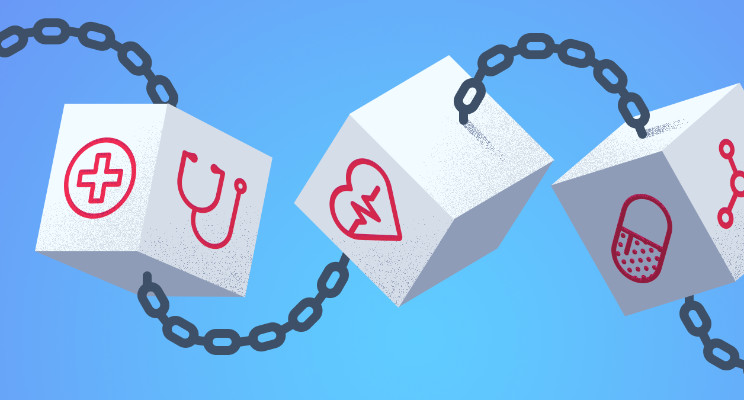
The Blockchain Revolution Comes to Healthcare
Last updated on June 23rd, 2022 at 04:29 am
Blockchain, which first emerged in 2008 with the development of the cryptocurrency Bitcoin, is being touted by many as the future of the Internet, and it is already being considered for application to a wide range of other industries. The healthcare industry is one of these, although its potential in this field has not yet been explored in practice. It nevertheless promises to bring in many revolutionary changes.
What is Blockchain Technology?
Blockchain is essentially a digital ledger used for data storage. It is a decentralized network that is located on many different computers simultaneously so that an alteration in the data on any one of them is immediately transmitted to all the others in the network. Each transaction recorded in the network is a “block of data,” and it is linked to all the other blocks in the system, forming a “chain.” All data in a blockchain is encrypted, and the process of linking each block to all the others is called “mining.”
What are the Advantages of Using Blockchain?
Blockchain allows data to be shared across many different computers simultaneously, but its usefulness goes much further. Since every data block in a chain is immutably linked to all the other blocks, any alterations in the chain must be transmitted to and accepted by all the other computers in the network. This makes it impossible for any block to be retroactively changed. All the data in the chain is also available to all the other users and cannot be hidden. The chain’s decentralized nature makes it difficult for hackers to break into it. All of this greatly enhances security and accuracy.
Uses of Blockchain in Healthcare
Blockchain has the potential to be fruitfully applied to many aspects of the healthcare industry. First and foremost, blockchain offers an ideal method for the storage of medical records given the unparalleled security it offers as described above, which will aid healthcare workers by eliminating inaccuracies and by protecting them in a legal sense in that it offers guaranteed integrity in data storage. Any data in a blockchain is fool-proof by its very nature. Blockchain will likewise improve the accessibility of patient data by healthcare providers. Blockchain also helps to prevent the mismatching or duplication of a patient’s records by ensuring that each patient is associated with only a single identifier. The need for improving access to medical records is clearly being demonstrated amidst the current COVID-19 pandemic.
Storing medical records in a blockchain also greatly increases the versatility of data used in medical research, since researchers can access large amounts of patient information all in one place. This can be useful in, for example, studying the results of a particular treatment method upon a large segment of patients. The ease of accessing the data eliminates the cumbersome need to deal with middlemen, giving those researchers who are granted access to it a direct way of getting the information they need.
In terms of the business side of healthcare, blockchain offers a much more efficient and speedy way of handling claim settlements, since the terms of the contract between the patient, his or her healthcare provider, and the payer can all be clearly set in advance. Furthermore, all parties involved can access the data they need without needing to go through intermediaries. This will save time for everyone and reduce the costs that institutions have to spend on staff working hours.
Blockchain can also possibly make things easier for pharma companies, which will have greater access to large amounts of patient data which they can use in the development of new products.
Lastly, Blockchain offers the possibility for the development of patient-centered interoperability, giving patients themselves greater access and authority over their own records and how they are shared. It can also make the relationship between a patient and his or her pharmacy easier given that the latter will have easy access to all the needed information.
Potential Problems in the Use of Blockchain
Despite its great potential, given that blockchain is still a very new tool, and since it has only been applied to cryptocurrencies thus far, it may present certain challenges once it is implemented in healthcare. First and foremost, because it is so new, it is completely unregulated, with no established rules to oversee its use. Thus, we may see problems emerge if and when it is adopted, such as in the area of privacy. Similarly, there is no established authority for letting users know who owns the data in a blockchain or who is granting permission for its use.
Second, given the massive size and scope of medical records across the healthcare industry, and the fact that a successful healthcare blockchain would require the incorporation of data from a vast number of sources, it is possible that the sheer amount of it could exceed the storage capacity of today’s blockchain technology. (All the data in a blockchain must be stored across all the computers linked to it.)
Lastly, since blockchain has not yet been applied to industries apart from the financial, the costs an institution in the healthcare field will incur in the installation and maintenance of one remain unknown. This may make providers hesitant to take on something new when they don’t know how much they will have to spend on it.
Blockchain: The Future?
While challenges and uncertainties remain, they are not any greater than those that were faced by previous technologies when they were first introduced, many of which ended up proving to be of great benefit to the healthcare industry. Blockchain may very well end up being one of these as well. Bruce Broussard, the CEO of Humana, has already stated his belief that blockchain will be the next big innovation in the field. Only time and experimentation will tell if his faith is justified.

Robert Snapp is a freelance healthcare writer and world traveler from San Luis Obispo, California with an educational background in biology and neuroscience. His work covers medical conditions like PTSD, Autism, Depression, and Wound Care among others.
